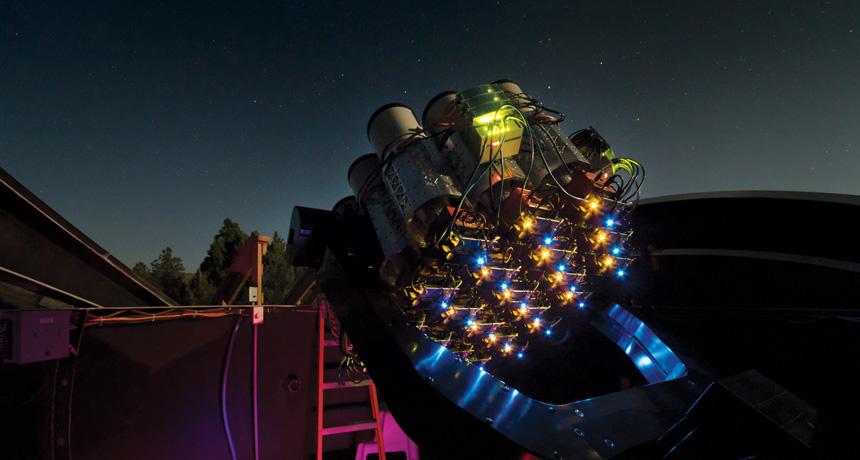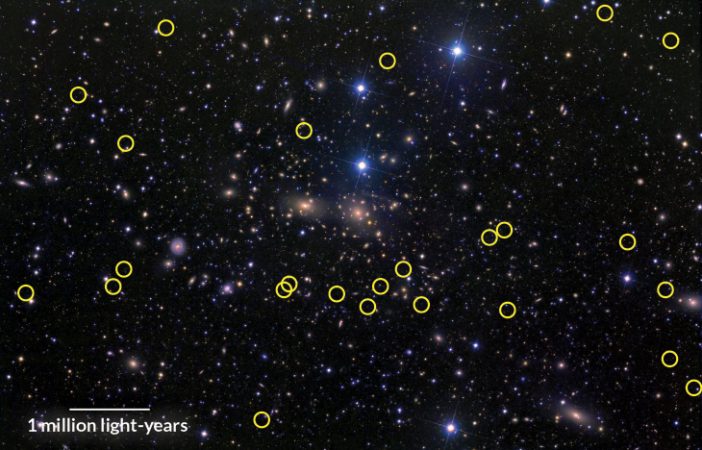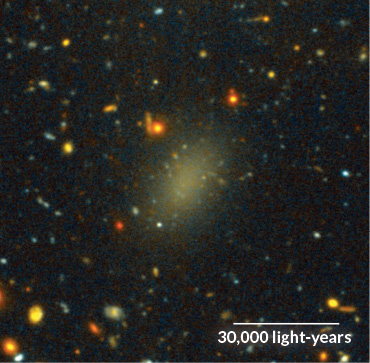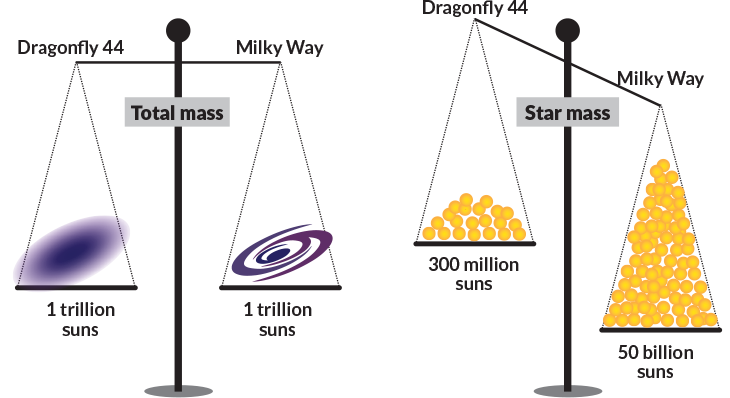Cosmic mystery: Why are many galaxies dark?
They have so few stars that their existence was unknown until 2015

Dark galaxies can’t be seen with the unaided eye. But the multi-lensed Dragonfly telescope (shown) in New Mexico can spot them. It has triggered a hunt for dim galaxies in our cosmic neighborhood.
P. VAN DOKKUM
Galaxies are home to vast communities of stars, some likely numbering in the hundreds of millions. But not all of these stellar neighborhoods glow with starlight. Some galaxies as wide as the Milky Way are all but dark. Unlike Andromeda and other well-known galaxies, these dark beasts have no grand spirals of stars and gas wrapped around a glowing core. Nor are they radiant balls of densely packed suns. Instead, these may amount to no more than a wisp of starlight barely illuminating some tenuous blob.
“If you took the Milky Way but threw away about 99 percent of the stars, that’s what you’d get,” says Roberto Abraham. He’s an astrophysicist in Canada at the University of Toronto.
How these dark galaxies form is unclear. They could be a whole new type that challenges ideas about how such stellar communities form. Or they might be outliers of already familiar galaxies — some type of black sheep, shaped by their environment. Wherever they come from, dark galaxies appear to be everywhere. Astronomers reported the first batch in early 2015. That group showed other scientists what to look for. In no time, similar dark denizens were found inhabiting many nearby clusters of galaxies.
“We’ve gone from none to suddenly over a thousand,” Abraham says. “It’s been remarkable.”
This haul of ghostly galaxies has proved puzzling. Any galaxy the size of the Milky Way should have no trouble creating lots of stars — and light. But it’s still unclear how massive the dark galaxies are. Perhaps these shadowy entities are failed galaxies. Despite being as massive as our own, some unknown factors may have kept them from giving birth to a vast family of stars. Or despite being as wide as the Milky Way, our dark neighbors could be relative lightweights and stretched thin. If there is not enough tightly condensed mass, they may not have had the critical heating and density to fire up much star formation.
Either way, with so few stars, dark galaxies must have enormous deposits of unseen matter. If not, the gravity of neighboring galaxies would have pulled them apart.
Astronomers can’t resist a good cosmic mystery. With the number of these dark oddballs piling up, there is a push to figure out just how many exist and where they’re hiding. “There are more questions than answers,” says Remco van der Burg. He’s an astrophysicist at CEA Saclay, near Paris, France. Cracking the code of dark galaxies could help scientists better understand how all galaxies formed and evolved, including our Milky Way.
Seeing like a dragonfly
Finding these strange galaxies took a new type of eye on the skies — a telescope system with cameras and no mirrors.
The general rule for telescopes is that bigger is better. A large mirror or lens can collect more light to spot fainter objects. But even the biggest telescopes have a limitation: unwanted light. Every surface in a telescope is an opportunity for light coming in from any direction to reflect onto the image. This scattered light shows up as dim blobs, or “ghosts.” And this ghostlight can wash out faint details, or even mimic very faint galaxies.
Large dark galaxies look a lot like these ghosts. That’s how they went unnoticed for millennia. Until, that is, a new type of telescope began scanning the skies.
Called Dragonfly, it was designed to limit this ghostlight. Unlike most light-imaging telescopes, it has no mirrors. The New Mexico telescope actually looks more like a honeycomb than a traditional observatory. It started in 2013 as three telephoto lenses, each attached to a camera. But it continues to grow. Today it has 48 lens-camera combos. All point at once to view the same part of the sky. Precision anti-reflection coatings on the lenses keep scattered light to a minimum. Now, if the same blob shows up in every camera, it’s probably real — and not stray light bouncing around in the device.
Partly inspired by the compound eye found in dragonflies (hence its name), this relatively small scope has revealed dim galaxies missed by other telescopes.
“It’s a very clever idea, very brilliant,” says Jin Koda. He’s an astronomer at Stony Brook University in New York. “Dragonfly made us realize that there is a chance to find a new population of galaxies beyond the boundary of what we know so far.”
In spring 2014, researchers pointed Dragonfly at Coma. This is a well-studied cosmic cluster containing thousands of galaxies. At a distance of about 340 million light-years, Coma is relatively close. Its densely packed collection of galaxies offered a rich hunting ground for astronomers. They hoped to spy far-flung stars and stellar streams. This might offer evidence of the carnage left behind after small galaxies collided to build larger ones.
Three years ago, astronomers were looking at the edges of Coma galaxies. And what they discovered was a complete surprise: dozens of new galaxies hiding in plain sight.
“People have been studying Coma for 80 years,” Abraham says. Along with astronomer Pieter van Dokkum of Yale University in New Haven, Conn., he had been leading the team. “How could we find anything new there,” Abraham wondered? And yet, scattered throughout the cluster appeared 47 dark galaxies. Many were roughly as big as our Milky Way — tens of thousands to hundreds of thousands of light-years across.
This was puzzling. A galaxy that big should have no problem forming lots of stars, noted van Dokkum and the others, last September, in Astrophysical Journal Letters.
How did they survive the ‘bullies’?
Even more surprising, says Abraham, is that those galaxies have survived amidst a crowd of galactic bullies.
A galaxy’s gravity holds its community of stars together. But the gravity from neighboring galaxies can pull hard enough to rip a smaller one apart. To create enough gravity to survive on its own, a galaxy needs heft. That mass will exist as stars, gas and other cosmic matter. In a place like Coma, a galaxy needs to be fairly massive or be densely packed. But with so few stars (and likely little mass) spread over a relatively large space, dark galaxies should have been shredded long ago by their neighbors’ gravitational tugs.
This suggests the dark ones may be recent arrivals to Coma. There also is another possibility: Dark galaxies may be a lot stronger than they would at first appear.
From what researchers have learned so far, dark galaxies seem to have been lurking for many billions of years. They show up throughout their home clusters. This suggests they’ve had a long time to spread out and mingle among the conventional galaxies. And the meager stars found in dark galaxies are mostly red and fairly cool. Their low-energy light points to their likely being elderly. For the dark galaxies to have survived so long, they just have some hidden strength. The likely explanation: loads of dark matter.
All galaxies have plenty of dark matter — a mysterious substance that reveals itself only via gravitational interactions with glowing gas and stars. Much of that dark matter exists as an extended blob. Known as a halo, it reaches well beyond the visible edge of its home galaxy. On average, dark matter accounts for about 85 percent of all matter in the universe. But for there to be enough gravity to keep Coma’s dark galaxies intact, dark matter must make up about 98 percent of the mass in their core regions. That’s what van Dokkum’s team calculated.
If true, dark galaxies would appear to have a similar share of dark matter near their cores as the Milky Way does throughout its broader halo. Astronomers had never seen such a strong preference for dark matter in galaxies that are so large.
The initial collection of dark galaxies with unusual traits lured more researchers into the hunt for these strange celestial communities. The scientists pored over existing images of Coma and other clusters. Dark galaxies are so faint that they could easily blend in with a cluster’s background light or be mistaken for reflections within a telescope. But once the galaxy hunters knew what to look for, they were not disappointed. Those first 47 turned out to be just the tip of the iceberg.
In June 2015, Koda’s team at Stony Brook was looking at old images of Coma taken by the Subaru telescope in Hawaii. They easily confirmed that those 47 were truly there. There were also many, many, many more.
In all, they turned up 854 dark galaxies. Of these, 332 appear to be roughly as big as the Milky Way. Further calculations led the team to conclude that Coma could harbor more than 1,000 dark galaxies of all sizes. If true, that would be roughly as many as its number of known, well-lit galaxies!
Story continues below image.

And Coma is not the only site for dark galaxies. Three more showed up in the sparsely populated Virgo cluster of galaxies. In August 2015, astronomer Christopher Mihos of Case Western Reserve University in Cleveland and his colleagues reported this trio. These galaxies are a mere 54 million light-years away.
In June 2016, van der Burg and his collaborators reported another windfall. They used a telescope atop Mauna Kea in Hawaii to assess the masses of several galaxy clusters. Taking a closer look at eight clusters — all less than about 1 billion light-years away — the group found roughly 800 more ultra-diffuse dark galaxies.
“As we go to bigger telescopes, we find more and more,” says Michael Beasley. He’s an astrophysicist at Spain’s Instituto de Astrofísica de Canarias in Santa Cruz de Tenerife. “We don’t know how many there are,” he says, “but we know there are a lot of them.” He posits that there could even be more dark galaxies than bright ones!
Maybe the environment of a star’s nursery matters
What dark galaxies are and how they form is still a mystery. For most of them, researchers know only how big and how bright each is. To date, the masses of only three have been measured. Two of them appear to have more in common, at least in terms of mass, with small galaxies that orbit the Milky Way. Their total masses are on the order of about 70 billion to 90 billion times the mass of our sun. (For comparison, an October 2016 estimate in The Astrophysical Journal puts the mass of our Milky Way at 650 billion to 700 billion times that of our sun. Other estimates say our galaxy may have one trillion times the sun’s mass.)

Yet only about one one-thousandth of the mass or less in those dark galaxies comes from stars. The rest is dark matter. That puts the total masses of these two galaxies on a par with the Large Magellanic Cloud. It’s the largest of the satellite galaxies orbiting our Milky Way. But focus on just the mass of its stars and the Large Magellanic Cloud is about 35 times as massive of one of those dark galaxies and 100 times as big as the other. Beasley and his teammate Ignacio Trujillo, also at the Tenerife institute, shared their analysis October 4 in The Astrophysical Journal.
The third measured dark galaxy, dubbed Dragonfly 44, is another story. It’s a dark beast. It weighs about as much as the entire Milky Way, yet is made almost entirely of dark matter. Or so van Dokkum and his colleagues report in the September 1 Astrophysical Journal Letters. “It’s a bit of a puzzle,” Beasley says. “If you look at simulations of galaxy formation, you expect to have many more stars.” For some reason, this galaxy came up short — despite having roughly 1 trillion times the sun’s mass.
The environment may be to blame. A cluster like Coma grows over time by drawing in galaxies from the region around it. As galaxies fall into the cluster, they feel a headwind as they plow through the hot plasma — ionized gas — that permeates the cluster. That headwind can strip gas from an incoming galaxy. Yet galaxies need gas to form stars, which are created when self-gravity crushes a blob of dust and gas until it turns into a thermonuclear furnace.
If a galaxy falls into the cluster just as it is starting to make stars, this headwind might remove enough gas to prevent many stars from forming. That might keep this galaxy largely in the dark.
Or maybe there’s some feature special to certain galaxies that turns them dark. A volley of exploding stars (supernovas) or a prolific burst of star formation might blow gas out of the galaxy.
All galaxies rotate. But perhaps dark galaxies are a subset that twirl so fast that their stars and gas have spread out. That’s an idea that has been floated by Nicola Amorisco of the Max Planck Institute for Astrophysics in Garching, Germany, and Abraham Loeb of the Harvard-Smithsonian Center for Astrophysics in Cambridge, Mass. This pair suggest that dark galaxies may have started as small neighborhoods that spun rapidly as they formed. It’s possible that this could have turned them into diffuse blobs rather than star-building machines. They described the idea in the March 2016 Monthly Notices Letters of the Royal Astronomical Society.
Story continues below image.

To learn more . . .
To test these and other ideas, astronomers are focused on two key pieces of information: the masses of these galaxies and where they sit. Mass can help researchers distinguish between different birth scenarios. For instance, they might suggest whether dark galaxies were giants like the Milky Way that merely failed to light up with stars.
A survey of other regions would indicate whether dark galaxies are unique to big clusters such as Coma. But if they turn up outside of such clusters, then perhaps they’re just born that way.
And there’s already a hint that might be the case.
Yale astronomer Allison Merritt and her colleagues reported in October 2016 that they’d spied four dark galaxies lurking in a small galactic community about 88 million light-years away. That would seem to indicate that massive Coma-like clusters are not the only places where dark galaxies lurk.
And van der Burg, in his survey of eight clusters, found that dark galaxies make up the same fraction of all galaxies in a cluster regardless of how massive that cluster is — at least, for clusters weighing between 100 trillion and 1 quadrillion times the mass of our sun.
Dark galaxies may require new ideas about galaxy formation. Or they might just be one page from the galaxy-recipe book. Timing, location and luck might send some heavenly neighbors toward a bright future and force others to fade dimly into the background. Perhaps dark galaxies are a mixed bag, the end result of many different processes going on in a variety of environments.
“I see no reason why the universe couldn’t make these things in many ways,” says Abraham of Toronto. “Part of the fun over the next few years will be to figure out which is in play in any particular galaxy and what sort of objects the universe has chosen to make.”
What is clear is that as astronomers push to new limits — fainter, farther, smaller — the universe turns up new surprises.







